The Vietnam Coffee and Cocoa Association would like to introduce a brief history of the coffee industry:
Discover
According to legend, the appearance of coffee began in the year 600 with the discovery of tea coffee. The legendary story of coffee is associated with the accidental discovery of a goat herder named Kaldi while he was herding goats in a mountainous area in present-day Ethiopia. While Kaldi fell asleep, his herd of goats began to scatter around. A few hours later, he woke up and was extremely scared when he could no longer see his goats. Kaldi started searching, and when he finally found the goats, an amazing sight met his eyes. The goats were very excited and were jumping on their hind legs. Kaldi searched around and discovered that his goats had eaten red fruits on a very strange tree. Kaldi felt worried because he was afraid that the goats would get sick because they ate strange fruits.
Kaldi had to spend a lot of time getting the goats back to the barn, and he decided not to tell his parents what happened. The next day, when released outside, Kaldi’s herd of goats returned to the strange bushes from the previous day and began to eat the red fruits. Kaldi paid close attention and noticed that the strange fruits did not affect the health of the goats. He ventured to try a few fruits, and immediately he felt refreshed and alert.
After that, Kaldi brought the strange fruits home and told the story to his parents. Kaldi’s parents gave some to monks at a nearby monastery. The monks were very happy because, after chewing the fruits, they felt alert, no matter how long the prayer period lasted. The monks decided to dry the strange fruits so they could take them to distant monasteries. There, they mixed water with dried fruits to create a new drink.
Formation and development
After Kaldi discovered strange fruits that could help refresh and alert the mind, his story spread quickly to the Middle East. Coffee cherries were transported from Ethiopia to the Arabian Peninsula and grown on land in present-day Yemen. In Yemen, people use coffee pods to make a type of tea. It wasn’t until Turkey appeared that people began roasting coffee beans and creating the kind of coffee we have today.
During that time, the Arabs always tried to keep the secrets of the coffee plant a secret. No one is allowed to carry raw coffee beans, but only roasted and ground coffee. Around 1640, although roasted coffee appeared in England and Europe, only the Arabs knew the exact type of seed and shape of the coffee plant.
Until the early 1700s, the Dutch tried to steal a coffee tree from Yemen, and from then on, the whole world began to know about the coffee tree. The Dutch first introduced the coffee plant in Java, Indonesia, and then coffee spread throughout the world.
Coffee shops sprang up quickly throughout Europe and became information exchange centers for the intellectual class. In the 1700s, black coffee was brought to America by a French infantry captain who planted and cared for a small coffee tree during the long journey across the Atlantic. This coffee tree was replanted on the land of the Caribbean island of the country of Martinique, and this is the original coffee tree that gave birth to more than 19 million seedlings on the island within 50 years. From such simple beginnings, coffee trees have been widely grown throughout the tropical regions of South and Central America.
At that time, the US Congress decided to approve coffee as a national beverage to protest the high tax rate on tea issued by the British King at that time.
Today, coffee growing and processing has become a global industry that creates jobs for more than 20 million people. The global trade value of coffee is second only to oil.
With an estimated annual consumption of over 400 billion cups, coffee is recognized as the most common and popular beverage in the world. Currently, coffee is grown in more than 80 countries worldwide.
The most commonly grown commercial coffees are Robusta coffee (Coffea canephora) and Che coffee (Coffea arabica). In some countries, people also grow Jackfruit coffee (Coffea exelsa), but the market demand for this type of coffee is still relatively low.
The tea coffee tree belongs to the Catimor genus. It is also known as the dwarf variety. Catimor is a cross between Hybrido de Timor and Caturra. This variety was created in the 1980s. A tree of the Catimor variety can grow up to 2.5 meters tall. Catimor coffee beans produce poorer water quality than other tea varieties because of their lower acidity and flavor (two important characteristics that determine quality and taste).
The leaves of Robusta coffee are usually larger than those of tea coffee, and the tree can produce fruit for a longer period of time. The fruit and kernel of Voi coffee are easy to distinguish from Che coffee because of their rounder shape. Robusta coffee can be 7 to 10 meters tall. Robusta coffee beans make the water more bitter. Some markets like this feature, but others do not. Therefore, Robusta coffee is often mixed with Che coffee.
The leaves of Jackfruit coffee are larger and rounder than the leaves of Che and Voi coffee. Jackfruit coffee can be more than 10 meters tall. The yield of Jackfruit coffee is relatively low. The taste of jackfruit coffee beans is more bitter and sour. Harvesting Jackfruit coffee is also more difficult due to the height of the tree. Furthermore, due to the low yield and quality of this variety, the current cultivation area is gradually decreasing.
Coffee development process in Vietnam
The French brought coffee to Vietnam around 1850. In the early 1900s, coffee was grown in some northern provinces, such as Tuyen Quang, Lang Son, and Ninh Binh. Tea and coffee are also grown in the Central Region, for example, in Nghe An and Ha Tinh provinces. Although tea coffee first appeared in Vietnam, there were also many Jackfruit coffee gardens (Coffea exelsa) planted during this time. It wasn’t until much later that the French began cultivating coffee gardens on the land of today’s Central Highlands.
Initially, people grew tea and coffee in the Central Highlands. During the process of growth and development, tea and coffee trees are so heavily rusted that they gradually degenerate. Finally, it was decided to replace Che coffee with Voi coffee and Jackfruit coffee.
In Quang Tri, the French also planted the first coffee trees, but later Jackfruit coffee.
During the 1990s, Vietnam’s coffee output increased rapidly, mainly due to:
Implement the policy of allocating land to farmers;
Coffee prices increased in 1994 and in the period 1996–1998.
Along with the policy of sedentary farming, many Delta people have migrated to live and intensively cultivate coffee in the Central Highlands. Large-scale coffee intensification takes place, most typically in the Central Highlands region. Most of the new coffee gardens planted during this period are Robusta coffee. Daklak province has become the province with the largest coffee area in Vietnam, and Daklak’s coffee output accounts for nearly half of the country’s total coffee output.
In recent years, the government has decided to stabilize the coffee growing area at 500,000 hectares to avoid deforestation and grow coffee when prices rise. Currently, Vietnam has the second largest coffee export volume in the world, second only to Brazil, and is the leader in Robusta coffee exports, with exports accounting for about 14% of the global market share.
UNCLE HO WITH COFFEE
The photo of Uncle Ho with the coffee tree was kept by the Information Center of the former Ministry of Agriculture (now the Ministry of Agriculture and Rural Development) and presented to the Vietnam Federation of Coffee Enterprises (now the Corporation). Vietnamese coffee 20 years ago had great significance, encouraging the entire coffee industry to strive for advancement.

Uncle Ho visited Dong Hieu Farm in Nghe An on December 10, 1961
It was a warm winter morning, December 10, 1961, a day that the staff, workers, and people of the Phu Quy area will never forget—the day Uncle Ho visited Dong Hieu Farm, one of five large farms under the Ministry of Agriculture at that time. Here, Uncle Ho spoke at a rally of more than ten thousand officials and workers from farms, factories, and local people who came to welcome Uncle Ho at the stadium of Dong Hieu Farm.
When the rally ended, Uncle Ho visited the farm’s production facilities. Uncle did not sit on the waiting Vonga, but the GAT 69 car with the old license plate BAA 827 of the farm director took him to visit the Nai Sinh production team (now the Dong Thanh team) and stopped by the coffee lot. No. 119. This is a batch of Typica coffee beans. In the plot, there are tall, wide-spreading black cassia trees that serve as shade trees for coffee. This month, tea coffee is in its ripe stage, and the fruit is full of branches. Uncle Ho asked comrade Huynh Son Thach, Secretary of the Party Committee, and comrade Tran Kim Manh, Director of Dong Hieu Farm, about coffee varieties, productivity, output, and coffee prices. When hearing the Secretary of the Party Committee report that the farm grew all three types of coffee, robusta, and jackfruit, Uncle Ho asked why the farm did not grow all types of coffee. He told workers to take care of increasing productivity and lowering product costs. For example, making a sample of coffee costs 1,400 VND (at that time, the cost of 1 kg of coffee was 7 VND), so you could only exchange it for a tractor. If the price is reduced to 700 VND, one acre of coffee can be exchanged for two tractors. He also told the staff to learn more scientific and technical knowledge to produce more and more coffee for export to enrich the country.
50 years have passed since implementing Uncle Ho’s teachings, and the coffee industry has matured significantly. It is also an expression of infinite gratitude and love for Uncle Ho. December 10 will go down in history and become a traditional day of the Vietnamese coffee industry.
Coffee is the name of a genus of plants belonging to the Rubiaceae family. This family includes about 500 different genera with over 6,000 species of tropical plants.
The coffee genus includes many different species of perennial plants. However, not all species contain caffeine in the seeds; some species are very different from the coffee plants we often see.
There are only two species of coffee that are economically significant. The first species has the common name in Vietnamese as Coffea arabica (scientific name: Coffea arabica), representing about 61% of coffee products in the world. The second species is robusta coffee (scientific name: Coffea canephora or Coffea robusta), accounting for nearly 39% of coffee products. There are also Coffea liberica and Coffea excelsa (in Vietnam called jackfruit coffee) with negligible output.
Featured
Coffee tree trunks
Robusta coffee tree trunks, when cut down, are often used to carve handicrafts.
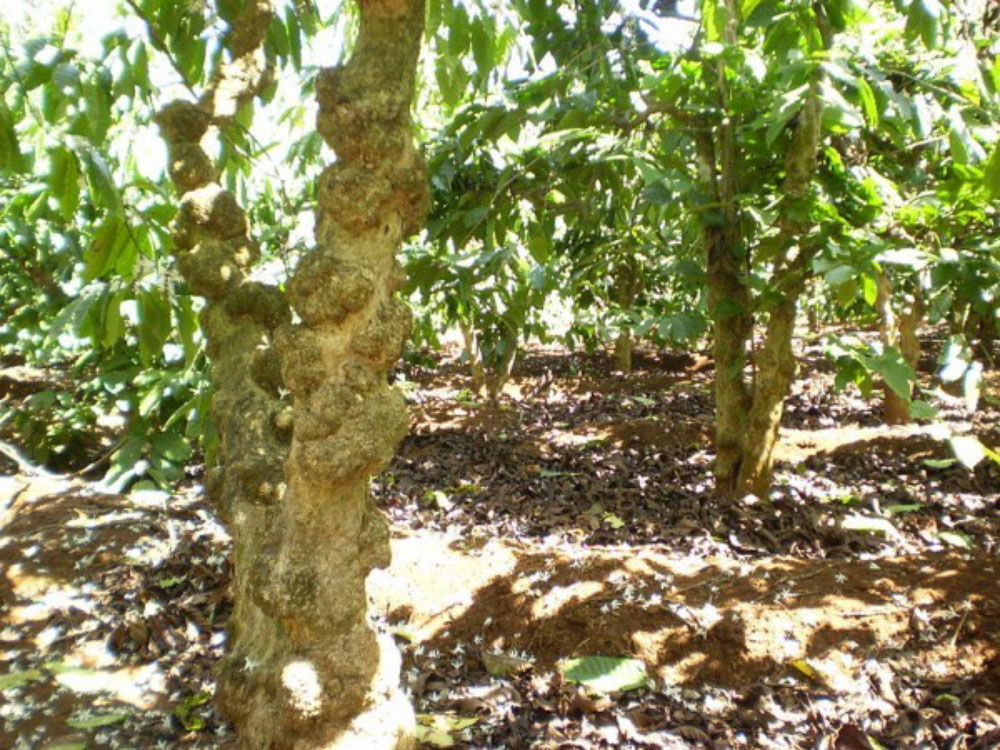
Robusta coffee tree trunks, when cut down, are often used to carve handicrafts.
The tea tree can be up to 6 m tall, and the robusta coffee tree can be up to 10 m high. However, on coffee farms, people often have to prune to maintain a height of 2-4 m, which is convenient for harvesting. Coffee trees have elongated branches and short-stemmed, dark green, oval-shaped leaves. The upper surface of the leaf is dark green, and the lower surface is lighter green. The length of the leaves is about 8–15 cm, and the and the width 4-6 cm. Coffee tree roots are tap roots, buried 1 to 2.5 m deep into the ground, with many secondary roots radiating around to absorb nutrients to feed the tree.
Flower
Coffee flowers are white, have five petals, and often bloom in double or triple clusters. The flower color and scent easily remind us of jasmine. The flowers only bloom for 3 to 4 days, and the pollination time is only a few hours. A mature coffee tree has between 30,000 and 40,000 flowers.
As soon as the coffee tree flowers and bears fruit, people have their first assessments of the coffee crop. In major coffee-producing countries, this is especially important when making judgments about prices and markets. However, severe cold spells or droughts can upset all calculations and push the market into a completely different situation.
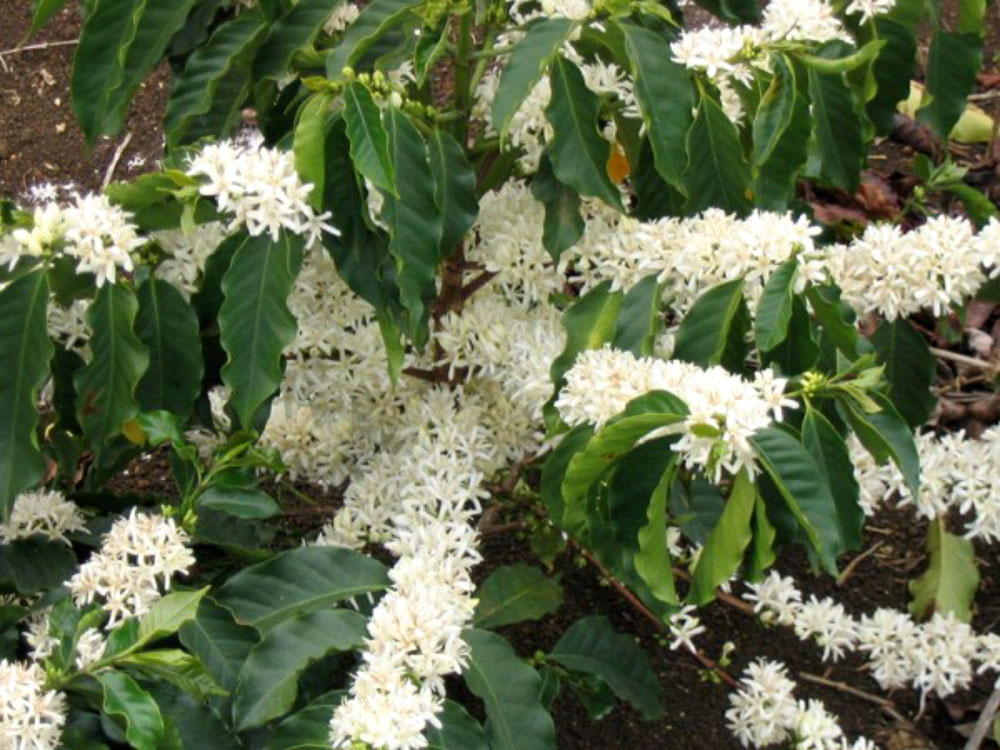
Fruit
Coffee is a self-pollinating plant, so wind and insects have a great influence on the plant’s reproductive process. After 7 to 9 months of pollination, the tree will produce oval fruits, similar in appearance to cherries. During ripening, the color of the fruit changes from green to yellow and finally to red. The fruit is black when it is ripe. Due to the long time it takes for flowers to bear fruit, a coffee crop lasts nearly a year, and it can happen that a tree has both flowers and fruits.
Normally, a coffee pod contains two beans. They are covered by an outer layer of fruit flesh. Two coffee beans are pressed together. The contact surface between them is flat, and the surface facing outward is arc-shaped. Each seed is also protected by two thin layers of membrane: a white layer tightly clinging to the seed coat, and a more discrete yellow layer covering the outside. Seeds can be round or long, and when fresh, they are yellow-gray, green-gray, or green. Occasionally, it is also seen that the fruit has only one seed (because there is only one kernel or because two seeds are stuck together into one).
Coffee fruit
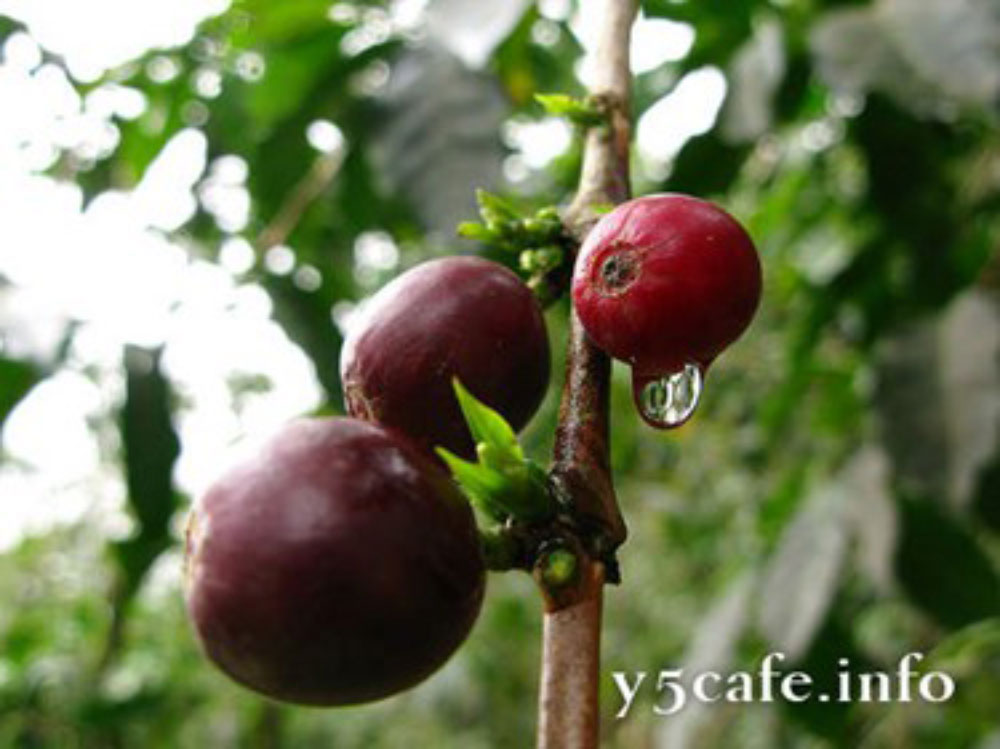
Crop year (year of production)
In Vietnam, the country currently leading the world in Robusta coffee production, the crop year is calculated from October to the end of September of the following year (according to the solar calendar). Harvest time in the Central Highlands provinces (which produces about 80% of Vietnam’s total output) usually lasts for 4 months, from the end of October to the end of January.
Immediately after harvest is the time when robusta coffee farmers start watering the plants and fertilizing them, divided into many short batches. This period lasts until April every year.
Some pictures of coffee trees

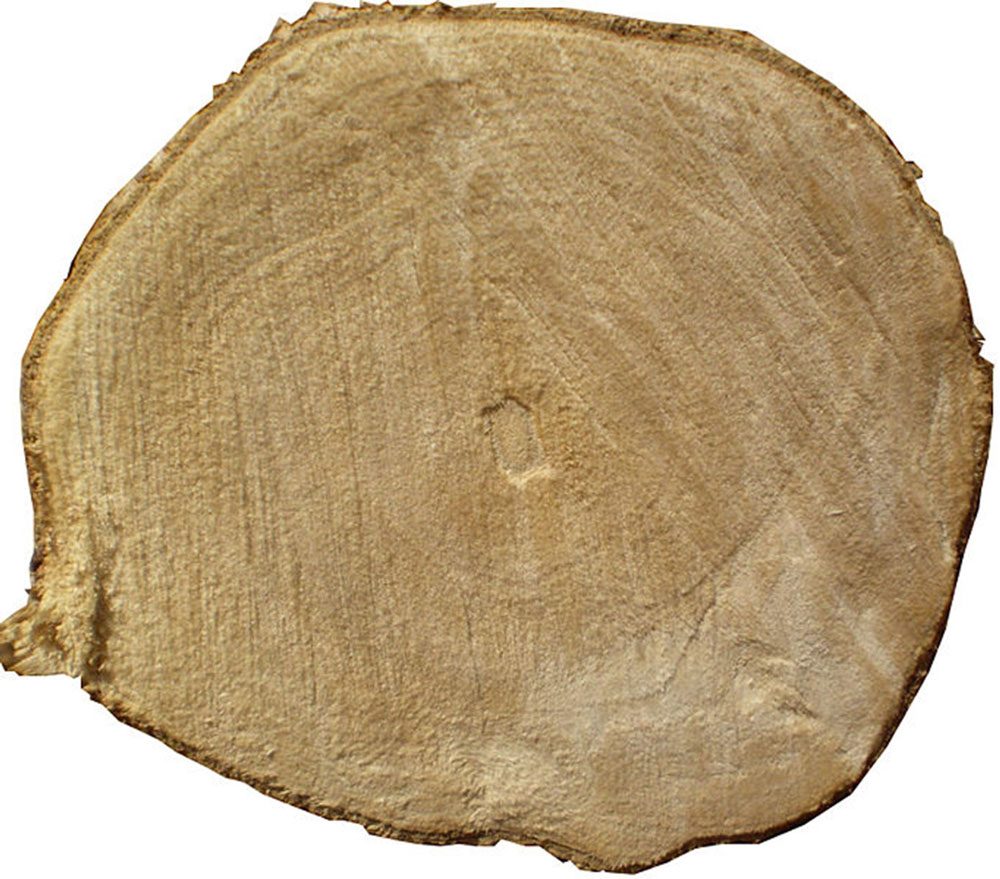
TEA COFFEE (ARABICA)
Coffee tea is the Vietnamese name of the coffee species (scientific name: coffee arabica) because this coffee species has small leaves. The tree is often kept low, like the tea tree, a popular industrial plant in Vietnam.
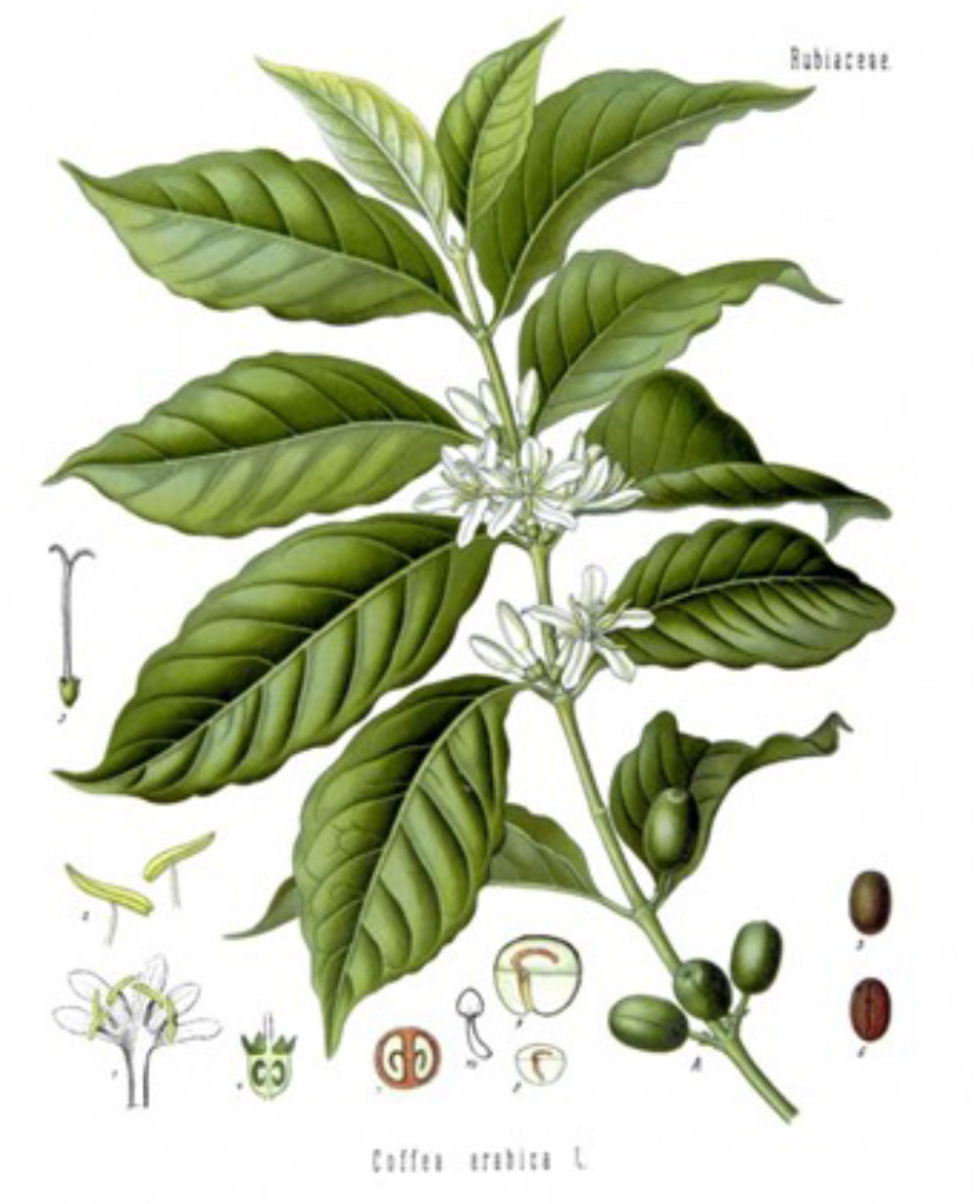
Image depicting a coffee tree
There are two types of this type grown in Vietnam: Moka and Catimor.
- a) Moka: seductive, sweet aroma, mild taste, but the yield is very low; the domestic price is not high because it cannot be exported; while the export price is very high—2–3 times higher than Robusta—because there is not enough growing Because of the cost, farmers rarely grow this type of coffee.
- b) Catimor: strong aroma, slightly sour taste, price is twice that of Robusta, but not suitable for the climate of the Central Highlands because the fruit ripens in the rainy season and is not concentrated, so the picking cost is very high. Currently in Quang Tri, this plant is being experimentally and widely planted and has very good prospects.
Arabica is the most economically valuable species among coffee plants. Coffee tea accounts for 61% of coffee products worldwide. Arabica coffee is also called Brazilian Milds if it comes from Brazil, Colombian Milds if it comes from Colombia, and Other Milds if it comes from other countries. From there, it can be seen that Brazil and Colombia are the two main exporters of this type of coffee, and their coffee quality is also highly appreciated. Other exporting countries include Ethiopia, Mexico, Guatemala, Honduras, Peru, and India.
Arabica coffee trees like to live in high mountains. People often grow it at altitudes of 1000–1500 m. The tree has a large canopy, a dark green color, and oval-shaped leaves. Mature coffee trees can be 4-6 m tall; if left to grow wild, they can be up to 15 m tall. The fruit is oval in shape, each containing two coffee beans.
Tea coffee can begin to be harvested about 3 to 4 years after planting. Usually, 25-year-old coffee is considered old and cannot be harvested anymore. In fact, it can continue to live for about 70 years. Arabica coffee plants prefer temperatures between 16 and 25 °C and rainfall of over 1000 mm.
In the coffee market, tea is more appreciated than robusta coffee (coffea canephora or coffea robusta) because it has a delicious taste and contains less caffeine. A bag of tea coffee (60 kg) usually costs twice as much as a bag of robusta coffee. Vietnam is the world’s second-largest coffee exporter, but mainly robusta coffee. In 2005, it is expected that the new coffee growing area will reach about 10% of the total coffee growing area in the country (about 40,000 hectares or 410,000 hectares).
The reason it is difficult to develop tea and coffee is because the altitude in Vietnam is not suitable. Coffee-growing areas in Vietnam, such as Buon Ma Thuot, Dak Lak, Bao Loc Lam Dong, etc., are only 500–1000 m high compared to At sea level, this plant has many pests and diseases, so it is not as economical as growing robusta coffee in Vietnam.
VOI COFFEE (ROBUSTA)
Voi coffee (also known as Robusta coffee or Ro coffee) has the has the scientific name Coffea canephora or Coffea robusta, which is the second most important plant among coffee species. About 39% of coffee products are produced from this type of coffee.
The world’s largest exporter of Robusta coffee is Vietnam. Other important exporting countries include Côte d’Ivoire, Uganda, Brazil, and India.
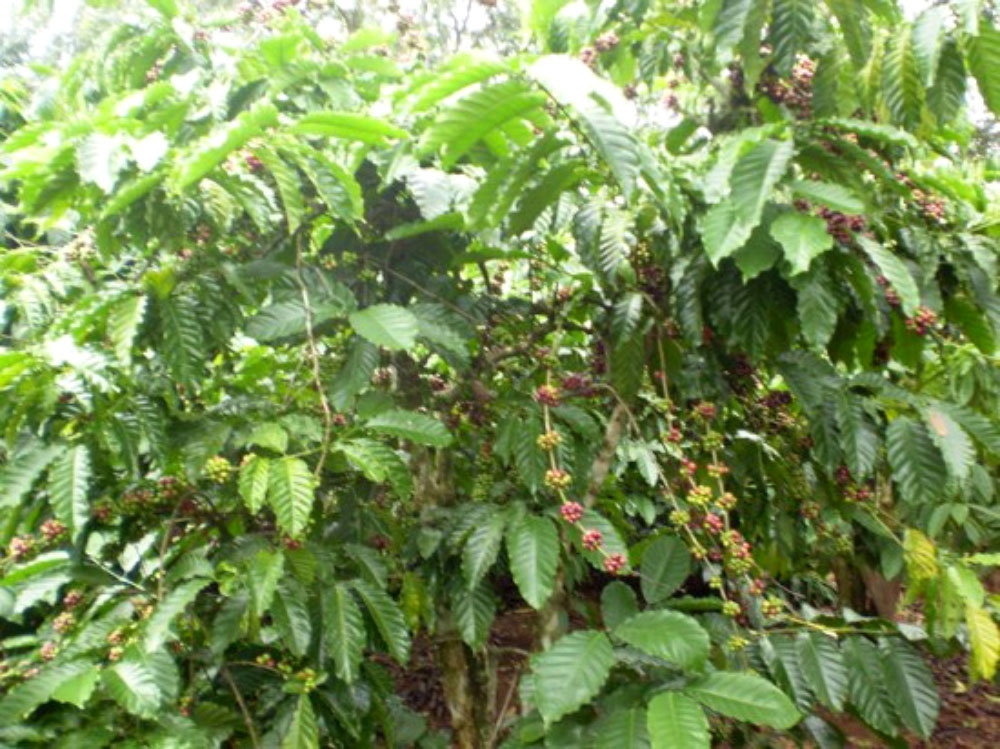
Characteristics of the Robusta coffee treeRobusta coffee trees have the form of trees or shrubs; the height of mature trees can be up to 10 m. Coffee beans are round in shape, and the seeds are smaller than Arabica coffee beans. The caffeine content in robusta coffee beans is about 2-4%, while in Arabica coffee it is only about 1-2%.
Like Arabica coffee, 3–4-year-old Robusta coffee trees can begin to be harvested. The tree produces seeds in about 20 to 30 years. Robusta coffee likes to live in the tropics; the appropriate altitude for growing trees is under 1000 m. The plant’s preferred temperature is about 24-29 °C, and rainfall is about 1000 mm. Robusta coffee plants need more sunlight than coffee plants.
Robusta coffee bean flavor
Robusta coffee contains a higher caffeine content and has a less pure flavor than Arabica coffee, so it is rated lower.
The price of a bag of canephora coffee is usually only half that of Arabica coffee. In 2004, Vietnam exported over 14 million bags of this type of coffee, accounting for nearly half of the world’s exported robusta coffee (over 30 million bags). Currently, nearly 90% of the coffee area in Vietnam is planted with robusta coffee, 10% is grown with tea, and the remaining 1% is grown with jackfruit coffee (Coffea excelsa).
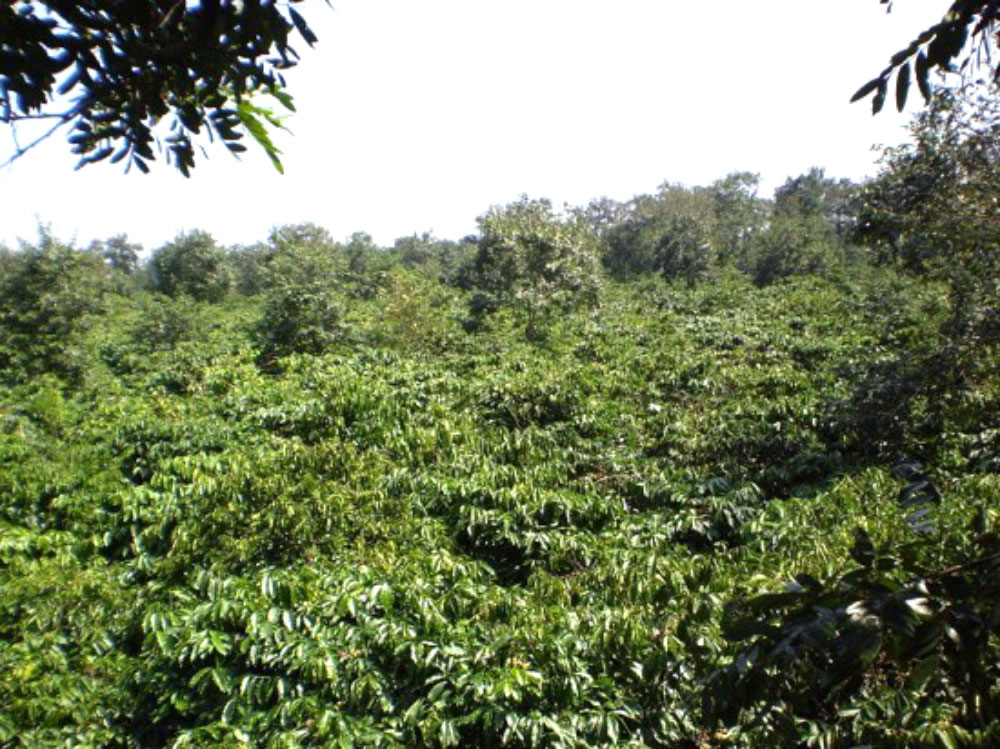
Robusta coffee fields in Cu Kuin
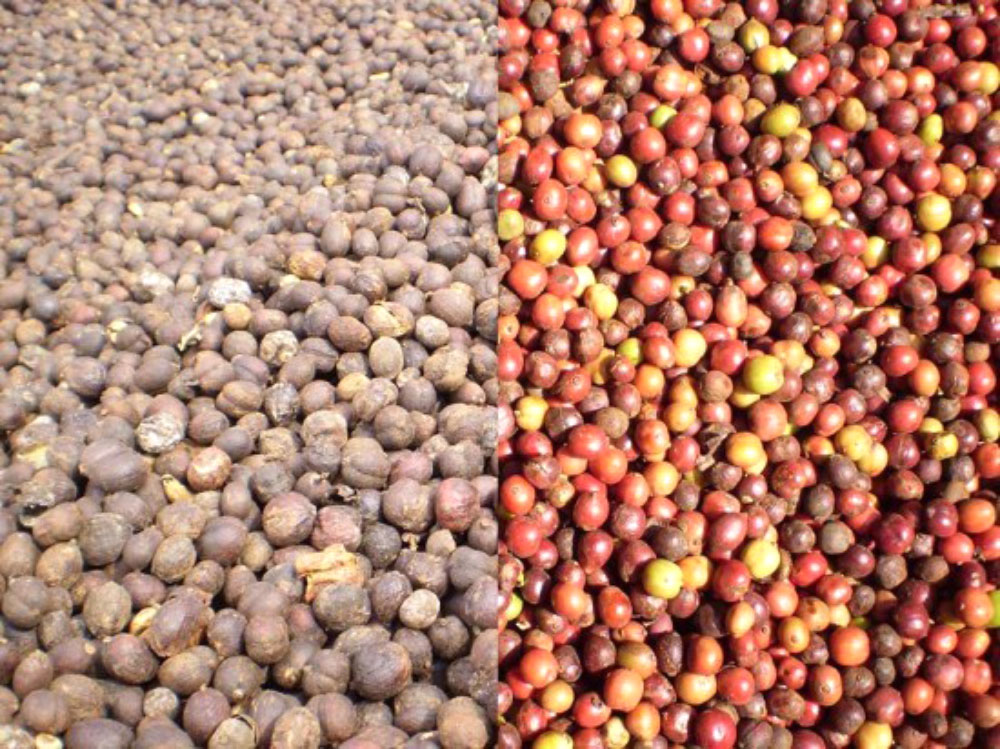
Robusta coffee beans are harvested, and the fruit is dried.
Jackfruit coffee (Liberia)
Jackfruit coffee, or Liberian coffee (scientific name: Coffea liberica, synonym: Coffea excelsa, belonging to the Rubiaceae family), is one of the three main types of the coffee family.
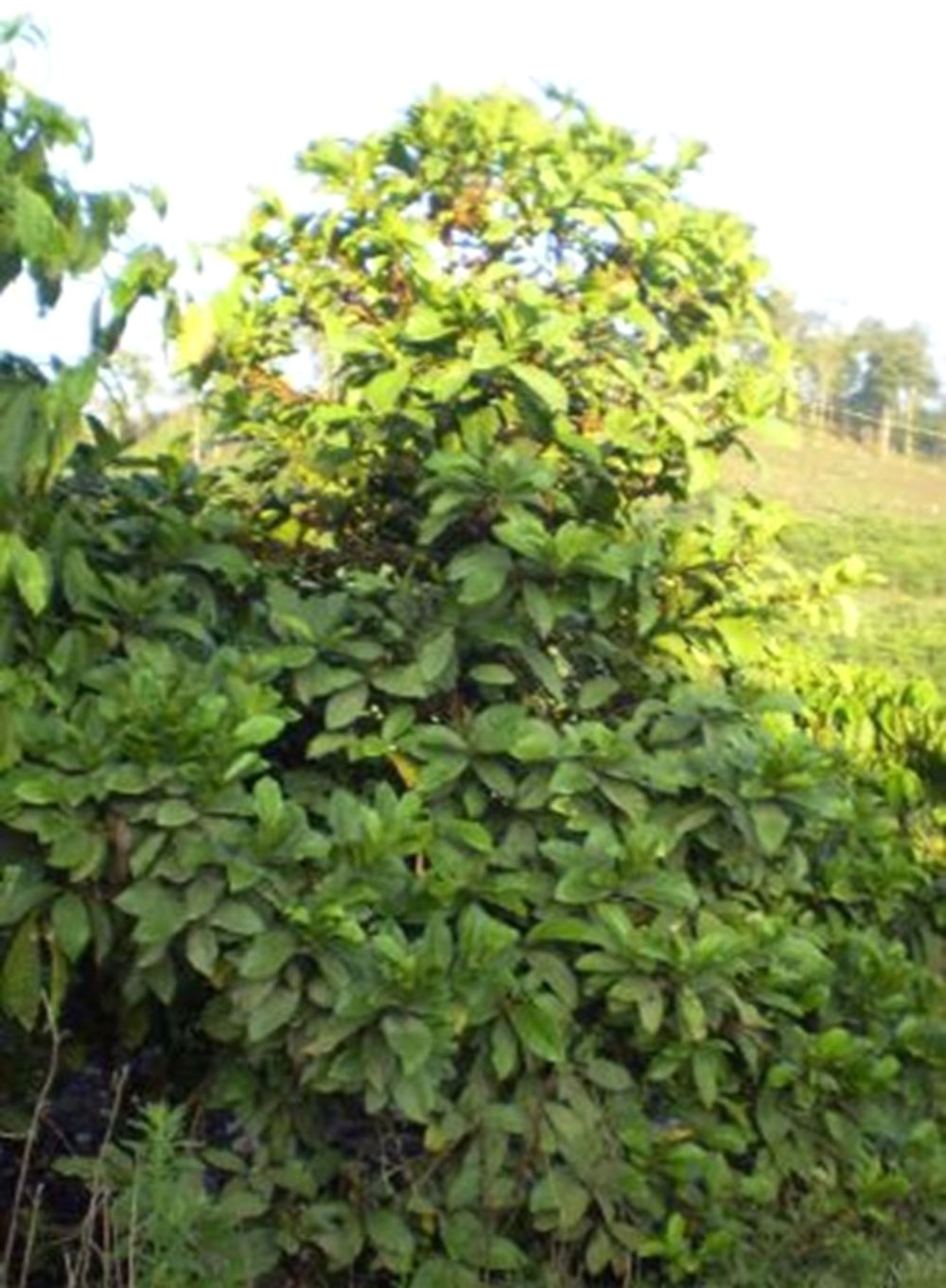
Jackfruit coffee tree
Distinguishing characteristics
The tree is 2–5 m tall. The stems, leaves, and fruits are all large, different from other types of coffee such as robusta coffee and jackfruit coffee. Because the leaves are large and dark green, they look like jackfruit from a distance, so it is called jackfruit coffee. The tree is drought-resistant and requires little water, so it is often grown extensively. However, due to its poor yield and low quality (sour taste), it is not popular and is not widely developed.
In Vietnam
In Vietnam, crops are grown mainly in provinces such as Nghe An, Gia Lai, and Kon Tum, which have suitable conditions for the development of industrial crops but are not entirely favorable for coffee development. This is also the reason why Dak Lak and especially Buon Ma Thuot are considered the capitals of coffee but have very little area for growing this type of coffee.
In the Central Highlands, Jackfruit Coffee often blooms and is harvested later than other coffee species due to its characteristics of blooming thanks to rainwater, and the fruit is usually harvested in the 12th lunar month, after other coffee species have been harvested. finished. The output of jackfruit coffee is not large; the kernels are large, elongated, and white. The trees are often planted as pure species or as windbreaks for robusta coffee plots, usually planted in rows with a distance of 5-7 m per tree.
Due to its drought resistance and high resistance to pests, jackfruit coffee is currently used as the rootstock for other types of coffee and is very popular with gardeners.
Jackfruit coffee beans are often mixed with robusta and tea when roasted to create flavor.
Unverified information: Jackfruit coffee often suits European tastes. European instant coffees often have a high proportion of jackfruit coffee, so they often have a characteristic sour taste.
Excelsa coffee (Coffea excelsa) is often called Jackfruit coffee.
The tree is over 10 meters tall, has a woody trunk, and has large leaves. The fruit ripens late, contains a caffeine content of about 2% of the seeds, and has a sour taste. It gives fruit for about 30–40 years. A suitable altitude is below 800 m, the average temperature is 26–30 oC, rainfall is over 1000 mm, and it needs a lot of sunlight. Easy to grow, has few pests and diseases, and requires little care.
The jackfruit coffee variety mainly originates from West Africa.
When the area and number of plantations increased significantly in the early 1950s, a third variety, tea coffee, was introduced into cultivation but was less popular because it was quite complicated.
Liberian coffee (Coffea liberica) is a variety also known as Jackfruit coffee.
Only grown in Liberia, Sierra Leone, and Equatorial Guinea in West Africa. Previously, in some plantations around Buon Ma Thuot and Dat Ly regions, Ea Pok appeared, but in insignificant quantities and was called Séri coffee. The tree is taller, has larger leaves like Excelsa, and ripens later with a sour taste. In Europe, they like to use it to mix with the other two types when roasting.
Taking a look at the basic characteristics of the main coffee varieties shows that choosing the right land for the tree is important, affecting productivity and product quality. If we want to bring it to other lands, it is necessary to select and find suitable, domesticated strains, and especially to have the involvement of plant breeding scientists. We cannot arbitrarily or willfully impose subjectivity on nature, like in the stories mentioned above.
So up to now, it can be said that coffee trees in Vietnam do not have a brand and have not developed in a truly sustainable way. It’s only recently that we’ve started to build the Buon Ma Thuot coffee brand in Vietnam. This is something that managers, policymakers, and crop care agencies need to pay attention to so that Vietnamese Robusta coffee can firmly affirm its number one position in the global market.
Source: Vicofa.org.vn


 Tiếng Việt
Tiếng Việt